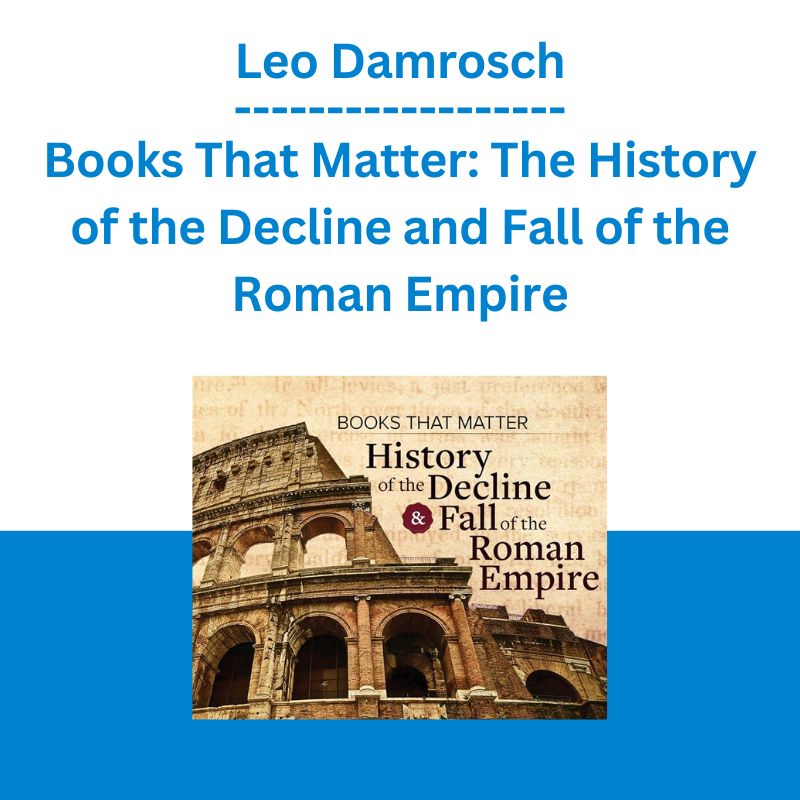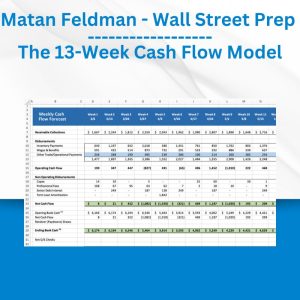*** Proof of Product ***
Exploring the Essential Features of “Leo Damrosch – Books That Matter: The History of the Decline and Fall of the Roman Empire”
Books That Matter: The History of the Decline and Fall of the Roman Empire
Join a Harvard professor to examine the meaning and impact of Edward Gibbon’s masterpiece.
LECTURE
Trailer
01:The Greatness of Gibbon’s Decline and Fall
Ground your understanding of Gibbon’s masterpiece with this helpful introductory lecture. Why was Rome so important to Gibbon and his readers? What makes the periodic style so essential to the Decline and Fall’s accessibility? Why should we want to read it today in the 21st century?
32 min
02:The Making of Gibbon the Historian
Follow Edward Gibbon’s intellectual development: his childhood obsession with reading, his military service, his disappointed love, his social circles, his personal politics, and his life as a “gentleman scholar of leisure.” Your primary source for this biographical study: fragments from Gibbon’s posthumously published Memoirs.
29 min
03:The Empire at Its Beginning
Before plunging into the Decline and Fall, which starts in the second century A.D., you need a little background in early Roman history. Professor Damrosch reviews the Empire’s important provinces (including their strange names), the excessive influence of the Roman military, the emergence of imperial dictatorship, and other facts Gibbon’s original readers took for granted.
30 min
04:The Theory and Practice of History
It’s no accident that the Decline and Fall survives as a great work of history. Here, explore how Gibbon understood the role of the historian; consider what he thought of Hume, Voltaire, and other Enlightenment writers; and discover how he revolutionized the use of extensive documentation in his work.
29 min
05:The Golden Age of the Antonines
Meet the Antonines: the subject of the first three chapters of the Decline and Fall. From Nerva to Hadrian to Marcus Aurelius, these “five good emperors” ruled “the only period of history in which the happiness of a great people was the sole object of government.”
30 min
06:The Hidden Poison Begins to Work
After the peace of the Antonines, things quickly began to fall apart. Describing the horrific reigns of emperors like Commodus, Caracalla, and Elagabalus, Gibbon illustrates the “hidden poison” by which one-man rule produced a vicious cycle of incompetent, power-corrupt emperors.
30 min
07:Diocletian and the Triumph of Constantine
Get a close reading of Chapters 8 to 14 of Gibbon’s masterpiece. In these pages, follow the first assaults of the barbarians who would eventually bring the Empire to its knees: the Goths. Also, meet two emperors who would radically reshape the structure of the Roman Empire: Diocletian and Constantine.
31 min
08:Enlightenment Skepticism
Consider just how dangerous Gibbon’s sociological treatment of Christianity in Chapters 14 and 15 (while grounding the faith in extremely detailed historical analysis) seemed to most of his readers. Rather than focusing on divine providence, the Decline and Fall documents the human causes behind Christianity’s evolution into the dominant ideology of the ancient world.
32 min
09:The Rise of Christianity
Continue your look at Chapters 14 and 15 of the Decline and Fall. In these pages, Gibbon takes up five causes for Christianity’s success, including proselytizing zeal the promise of a future life in heaven, but also unprecedented organizational ability. What Gibbon leaves out, however: any imaginative empathy with religion.
30 min
10:Constantine and Athanasius
Chapter 17 is the major turning point in the Decline and Fall. What are Gibbon’s thoughts on the transferring of the capital to Constantinople, and on Constantine’s famous vision of the cross? Why does he give so much attention to theological controversies, and why was he so impressed by Athanasius, the archbishop of Alexandria?
31 min
11:Julian and the Return to Paganism
Paganism in the Empire didn’t go down without a fight. Enter Julian the Apostate, who tried to reinstate the Olympian gods. Here, study Chapters 22 to 24, which are devoted to this last dying gasp of paganism-struck down by Julian’s death during an ill-advised military campaign, and afterward by pushback from the Christians.
30 min
12:Barbarian Advances and Theodosius
In the wake of Julian’s death there was great confusion, which occupies Chapters 25 to 28. Topics covered here include increased barbarian threats from in Britain, Germany, the Middle East, the Danube, and North Africa; the “chaste and temperate” rule of Theodosius; and Gibbon’s intriguing thoughts on Christian veneration of saints’ relics.
31 min
13:East and West Divided
With Rome’s fracture into eastern and western camps, the story of the empire’s decline begins to get complicated. Learn how to navigate the tricky waters of Chapters 29 to 33, which examine cataclysmic events including the sack of Rome in 410 A.D. and the loss of North Africa to the Vandals.
31 min
14:Huns and Vandals
Professor Damrosch guides you through successive waves of barbarian invaders, beginning with the assault of the Huns, led by Attila. You’ll also get Gibbon’s insights on the development of barbarian kingdoms, a sequence of nine Roman emperors in just 20 years, and his biased views on the growth of monasticism.
30 min
15:Theodoric and Justinian
The first was a Gothic king; the second Rome’s eastern emperor. Theodoric and Justinian (along with his general, Belisarius, and his wife, Theodora) dominate Chapters 39 to 44 of the Decline and Fall, which also examines Constantinople’s massive building program (including the Hagia Sophia) and the codification of Roman Law.
31 min
16:The Breakup of the Empire
After the fall of the empire in the West, how did Byzantium in the East persist for another nine centuries? Start with this look at Chapters 45 to 47, which cover the consolidation of France under Clovis, the establishment of the papacy as the center of Christendom, and a new swarm of religious heresies.
31 min
17:The Byzantine Empire and Charlemagne
Turn now to the fifth volume (of the original six) of the Decline and Fall, where the narrative starts to speed up. In addition to covering historical moments like the reign of Charlemagne and the Comnenian dynasty, you’ll also consider the implications of Gibbon’s “great man” approach to history from the 7th to 11th centuries.
29 min
18:The Rise of Islam
Step back in time to get Gibbon’s account of the rise of Islam. Occupying Chapters 50 to 52, this narrative emphasizes how, in Gibbon’s view, Islam arrived at a fortunate historical moment when it faced only weak opposition from surrounding powers; he also pays warm tribute to Muhammad’s qualities of character.
30 min
19:The Byzantine Empire in the 10th Century
At the end of the Decline and Fall’s fifth volume, you’ll survey the ever-shrinking form of the Byzantine Empire (Chapter 53), early Russians (Chapter 55), Norman conquests in the Mediterranean (Chapter 56), and the expanding dominion of the Turks (Chapter 57).
32 min
20:The Crusades
Gibbon’s account of the Crusades focused on the way religion was used to rationalize European military and territorial aggression. Learn what this master historian has to say about the rivalry of Richard the Lionheart and Saladin, the birth of the Crusader States, and military orders like the Knights Templar.
33 min
21:Genghis Khan and Tamerlane
Unpack another turning point in the Decline and Fall: Genghis Khan and the dawn of the Ottoman Empire. Central to this lecture is another of Gibbon’s charismatic figures: Tamerlane (known as the “scourge of God”). Then, end with Gibbon’s account of the discovery of gunpowder-which would forever change history.
30 min
22:The Fall of Constantinople
Chapters 66 to 70 chronicle the final defeat of Byzantium. Topics you’ll explore in this lecture include the exiled papal court at Avignon, Mahomet the Second’s capture of Constantinople, and the Great Schism from 1378 to 1417.
31 min
23:The End of Gibbon’s Work
How did Gibbon keep the Decline and Fall from simply petering out in its final chapter?What were some of his assumptions about the “darkness and confusion” of medieval Europe? See how his visit to the physical ruins of Rome inspired Gibbon’s final thoughts on the collapse of the empire and helped to bring his great work to a close.
29 min
24:Decline and Fall in Modern Perspective
Professor Damrosch ends his course with a reflections on the Decline and Fall in the 21st century. You’ll consider why some historians reject the term “fall” in favor of “transformation,” together with insistence by recent specialists that there truly was a fall; and also three major blind spots Gibbon exhibits in his history: toward religion, toward Byzantine civilization, and toward the persiste…
33 min
DETAILS
Overview
In this chapter-by-chapter guide, Professor Leo Damrosch of Harvard University helps you navigate the Decline and Fall’s themes, structure, and lasting influence. Whether you’ve read the book before or never knew where to start, these 24 lectures are an authoritative study of a once-mighty empire-and the great book that became its classic eulogy and epitaph.
About
Leo Damrosch
I think the greatest novels make you all too conscious of people’s limitations and wounds.
Dr. Leo Damrosch is the Ernest Bernbaum Professor of Literature Emeritus at Harvard University, where he has been teaching since 1989. He earned a B.A. from Yale University, an M.A. from Cambridge University, where he was a Marshall Scholar, and a Ph.D. from Princeton University. At Harvard, Professor Damrosch was named a Harvard College Professor in recognition of distinguished teaching. He has held National Endowment for the Humanities and Guggenheim research fellowships and has also directed National Endowment for the Humanities summer seminars for college teachers. Dr. Damrosch is the author of several books, including Tocqueville’s Discovery of America, Samuel Johnson and the Tragic Sense, Symbol and Truth in Blake’s Myth, The Imaginative World of Alexander Pope, Fictions of Reality in the Age of Hume and Johnson, and The Sorrows of the Quaker Jesus: James Nayler and the Puritan Crackdown on the Free Spirit. He also published a biography, Jean-Jacques Rousseau: Restless Genius, which was one of five finalists for the 2005 National Book Award in Nonfiction, and won the PEN New England/Winship Award for best work of nonfiction.
REVIEWS
Hotel Whiskey
Mesa AZ
Top Drawer
Although not the first lecture series on the Roman Empire that my wife and I have sat through, this was certainly the best of the lot. Top marks for organization and presentation of the material. Also, teaching the history of the Empire’s dissolution as perceived by a single writer provides useful continuity. Prof. Damrosch does an excellent job of explaining Gibbon’s biases and selectivity in assembling his history. That alone suffices to make this lecture series an achievement. HWF & ISF, Mesa AZ.
stan88
Excellent course
I have had the pleasure of watching or listening to many of the great course classes. This was one of my favorite. The professor did a fine job of presenting a large topic and making it easier to understand. I feel this topic is much better on video than it would be with audio. The professor did an excellent job presenting the material.
Please see the full list of alternative group-buy courses available here: https://lunacourse.com/shop/










 Erik Banks - Alternative Risk Transfer
Erik Banks - Alternative Risk Transfer  Greg Loehr - Advanced Option Trading With Broken Wing Butterflies
Greg Loehr - Advanced Option Trading With Broken Wing Butterflies  Ed Ponsi - Forex Trading
Ed Ponsi - Forex Trading  Toshko Raychev - Profit System + ITF Assistant
Toshko Raychev - Profit System + ITF Assistant  Forexmentor - Recurring Forex Patterns
Forexmentor - Recurring Forex Patterns  Atlas API Training - API 570 Exam Prep Training Course
Atlas API Training - API 570 Exam Prep Training Course  Racing Workshop - Complete Online Package
Racing Workshop - Complete Online Package  Trade Like Mike - The TLM Playbook 2022
Trade Like Mike - The TLM Playbook 2022  Dave Landry - Stock Selection Course
Dave Landry - Stock Selection Course  Simpler Trading - Bruce Marshall - The Options Defense Course
Simpler Trading - Bruce Marshall - The Options Defense Course  Sovereign Man Confidential - Renunciation Video
Sovereign Man Confidential - Renunciation Video  George Fontanills & Tom Gentile - Optionetics Wealth Without Worry Course
George Fontanills & Tom Gentile - Optionetics Wealth Without Worry Course  Oliver Velez - Essential Strategy Of Trade For Life
Oliver Velez - Essential Strategy Of Trade For Life  Money Miracle - George Angell - Use Other Peoples Money To Make You Rich
Money Miracle - George Angell - Use Other Peoples Money To Make You Rich  Emanuele Bonanni - My Trading Way
Emanuele Bonanni - My Trading Way  The Daily Traders – Exclusive Trading Mentorship Group
The Daily Traders – Exclusive Trading Mentorship Group  Akil Stokes & Jason Graystone - TierOneTrading - Trading Edge 2019
Akil Stokes & Jason Graystone - TierOneTrading - Trading Edge 2019  SMB - Options Training
SMB - Options Training